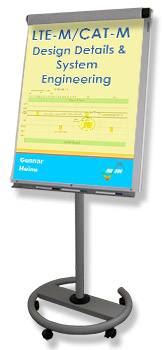 LTE-M / Cat-M1/M2 - Design Details & System Engineering
LTE-M / Cat-M1/M2 - Design Details & System Engineering
[2-day course, Euro 2,350.- (net) per participant]
 Training Course Description
Training Course Description
- This course addresses the needs of technical engineering staff who require a thorough understanding of of Cat-M / LTE-M.
- Cat-M is considered as a minor upgrade of existing LTE-A network and UE software but the understanding of the details and the operation of LTE-M is very complicated.
- This course has been designed to meet the requirements of both: engineering experts to design and test Cat-M related equipment, in particular on the UE-side and operations staff who require detailed knowledge about Cat-M network configuration.
- The course starts out with a short overview of long range IoT-technologies like NB-IoT and compares them with each other.
- This chapter ends with a detailed description of the various 3GPP-endorsed UE-categories for machine type communication.
- The whole next chapter is dedicated to a bit level elaboration of Cat-M operation.
- Starting with a thorough description of the details and meaning of CE-levels and CE-modes, the course continues with a detailed description as to how a BL-UE finds and reads the Cat-M related system information, namely but not limited to SIB1-BR.
- This chapter leaves no questions unanswered w.r.t. random access in Cat-M, resource allocation through MPDCCH and HARQ-operation.
- We also dedicated quite some focus on MCL-calculation for different channels under different circumstances to enable operators to come up with suitable repetition numbers.
- This chapter terminates with the calculation of achievable throughput rates in Cat-M, both uplink and downlink, to allow you benchmarking your own results from the field or from the lab.
- Focus of the next chapter is higher layer operation and starts out with the description of DRX-operation for Cat-M, distinguishing I-DRX and C-DRX. This part is a nice introduction for the following part: the detailed description of eDRX and its use in Cat-M.
- We will continue with a description of the specifics of the attach procedures for Cat-M, including an analysis of power saving modem its comparison with eDRX.
- The course ends with a description of control plane and user CioT-optimizations, their use cases and specifics.

Some of your questions that will be answered
- What are the differences between CE-level and CE-mode?
- How can blind retransmissions improve the overall system performance?
- How does the Cat-M UE find and read the BL-specific system information?
- How does the random access procedure work in LTE-M?
- How does a cell allocate resources in Cat-M? How does the MPDCCH operate?
- How does HARQ operate in LTE-M?
- What are achievable throughput rates in Cat-M in both directions?
- How does DRX operate for LTE-M?
- Which impact on DRX does eDRX have w.r.t. LTE-M?
- How do attachment and bearer setup work for LTE-M?
- How does PSM operate and how does it correlate with eDRX?
- How do CIoT-optimizations operate?
 Pre-Requisites
Pre-Requisites
- This is a bit-level course: The students should have detailed knowledge of LTE and LTE-Advanced prior to visiting this course.
 Training Course Target
Training Course Target
- The students be enabled to design, test and operate Cat-M enabled networks and UE’s in the field and in the lab.
 Training Course Duration
Training Course Duration
- 2 days
v1.000
ℹ️ Try out the updated search below!
Search:
More Info:
Detailed ToC of this training course
Schedule of this training course
Buy this book
INACON eBooks
Please have a look at our full offer

